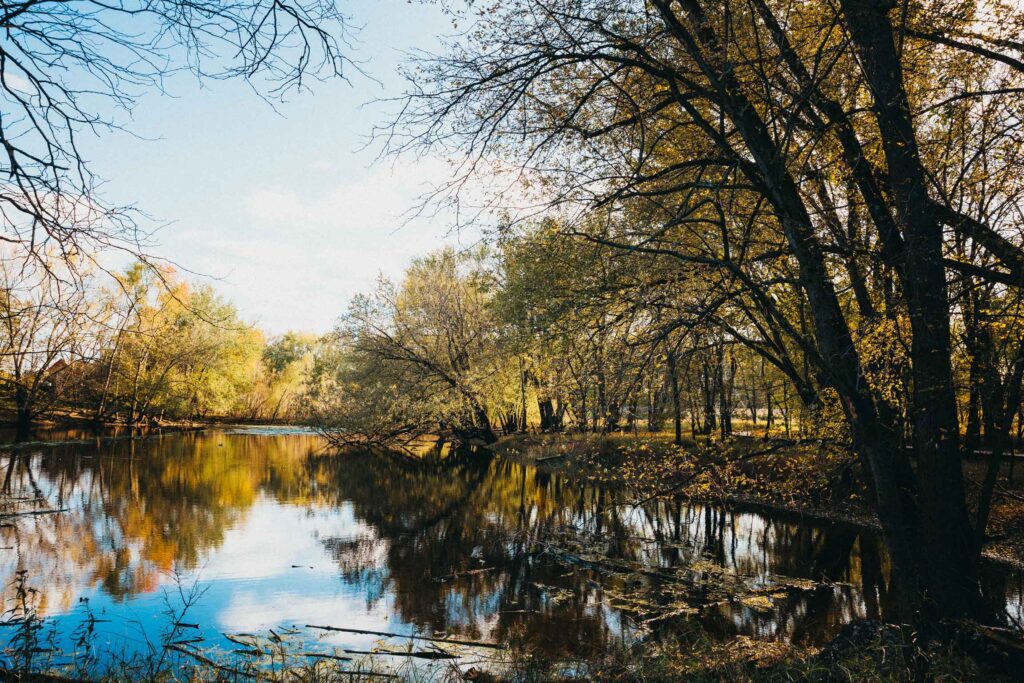George Schrimper wrote this essay about Indian Creek and the role it played in developing his love of nature for a Write Your Life Story program through the Iowa City Senior Center. George spent his childhood years in Cedar Rapids and many years as the Director of the University of Iowa Museum of Natural History. Please enjoy his stroll down memory lane and right through Indian Creek.
George Schrimper, November 25, 2018
Write Your Life Story (WYLS) writers and readers will know that most of the ditties that I’ve written over the years have connections to the natural world and environment. For the purposes of this essay I thought I would explain as well as I can how it all got started—my love and fascination with Mother Nature.
I owe it mostly to my mother. Every spring when I was a child she would gather up the kids in our Kenwood Park neighborhood in northeast Cedar Rapids and, like the Pied Piper, lead us on nature walks along the wildflower-spangled banks of Indian Creek. This was no small undertaking, as the creek was more than a mile away. We had to cross 1st Avenue which was a busy thoroughfare even back in the 1940’s. We skirted along the Ogden and Adams lumberyard, then maneuvered through the noisy industrial complex of buildings and storage yards of the LaPlant Choate factory (later becoming Allis Chalmers). Tranquility started to reign when we reached Mount Calvary cemetery. Here, my mother would instruct us to cease our childish frivolities, to walk quietly and respectfully among the gravestones and mysterious limestone mausoleums with their iron-barred gates.
We usually accessed Indian Creek at the iron truss bridge on 30th Street S.E. From there we could walk either north or south, but mostly my mother led us along the wooded west bank southward. Along the way, under the towering forest canopy, she would point out the ephemeral blossoms of Dutchmen’s britches, spring beauties, rue anemones, May apples, the occasional trout lily and jack-in-the-pulpit, and more rarely, perhaps a hepatica or trillium. With each of these discoveries there was a tone of wonderment to her voice. “Here! Over here! Look what I found!” I think she wanted to convey to us that it was all very special, perhaps a gift from God. Here was floral beauty within the city that no one had planned, planted, or plotted. Here was Nature for our appreciation. And as I reflect back on it now, I am sure that for her it was fondly reminiscent of her own childhood springtime explorations in my grandparents’ timber.
A few years later when I was old enough to trek down to Indian Creek on my own, a boyhood friend, Barry, and I would ride our bikes to the 30th Street bridge and stash them in the weeds. We would then walk the same rudimentary path along the creek used by my mother. About a quarter-mile to the south the trail arched steeply upward perhaps 40 feet in elevation to a limestone outcrop that we called Eagle’s Nest. There was a fascinating cave-like recess in the rock that permitted entry to about 10 feet. This feature was also known in neighborhood lore as Horse Thief Cave. Notwithstanding that the “cave” ended very plainly in solid rock, it was reputed that during the early settlement days of Cedar Rapids, thieves stashed their equine plunder here and then rode the horses underground all the way to another Horse Thief Cave which exits along the Wapsi River downstream from Anamosa. I’m not making this up, folks. If you want to check it out, there is a small cave in Wapsipinicon State Park—all of 30 feet deep—to keep alive the legend.
My friend and I often carried our fishing rods on our bikes down to the creek. We caught chubs and occasionally a yellow-bellied bullhead. I still vividly recall landing a 10-inch chub, a bragging-rights giant of that species. My father had a two-person minnow seine about 10 feet long. (I now have this 80-plus year-old artifact.) Barry and I would seine the gravelly riffles in the creek. The net would come up shimmering full of minnows (minnies to us) and crayfish, better known in the neighborhood vernacular as crawdads or crawdaddies. Later, when I was a hip teenager, crawdaddies became crawdaddy-o’s.
The miniature lobster-like crawdaddies were both bountiful and versatile. Besides seining for them, we waded Indian Creek and gigged them with a broom handle fitted on one end with two sharpened nails. Crawdaddies could also be caught with a fishing rod and line baited with—what else—the freshly peeled tail meat of a crawdaddy. And for anyone in WYLS inclined to give it a try, when a crawdaddy “bites”, that is, when it picks up your bait with its big front claws and tugs so very gently on the line, you must reel in very S-L-O-W-L-Y. Otherwise, your crawdaddy will sense that something is amiss and let go of the bait. It took me many years to acquire the expertise that I now so generously and altruistically share with my fellow WYLS writer-readers. Please do not share this insider tip with anyone outside this room!
I noted above that crawdaddies are “versatile.” They aren’t especially warm and cuddlesome nor do they have a lot of personality, but you can keep them as pets. We kept our pet crawdaddies in a water-filled coaster wagon and wheeled them around the neighborhood to show to the other (envious) kids.
You can also eat them. Yes, crawdaddies are quite tasty. Laced with hot Tabasco sauce, they are served in many Southern restaurants and especially so in Louisiana where they are called “mudbugs.” If you are interested in this fiery finger food, be prepared to get messy. And if you want to look like one of the savvy locals, after peeling the exoskeleton—the “shell”—off the meaty tail and eating it, you suck the entrails and body juices out of the head and carapace with as loud of a slurping sound as you can muster.
My childhood buddy and I were not so savvy with the culinary arts. However, we foraged natural foods along the banks of Indian Creek on day-long forays that we called “survival hikes.” A favorite repast was crawdaddy tails boiled in an old tin can over an open fire.
Let me know if you would like to have the recipe.
Note: The farm and adjoining timber where my mother played as a child is now the Twin Pines golf course in Cedar Rapids. The property was pioneered by my maternal great, great grandparents, Gottfried and Mary Quaas, who emigrated from Germany in 1849. My grandfather, William Andrew Quaas, planted the namesake “Twin Pines.” My mother and two aunts were born on that property. The area was still rural cropland and forest when I was growing up.

